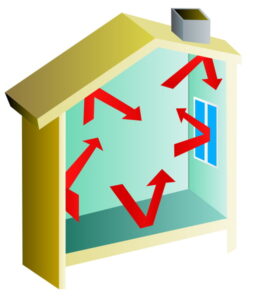
You may have never heard of the “stack effect” before (no, it has nothing to do with Robert Stack from The Untouchables), but it has a huge effect on your home heating in Maryland. Although you don’t have to be an expert on how your home enjoys warmth during the winter—that’s why you have HVAC professionals like us around—a bit of knowledge can go a long way toward helping you to understand how your house may be losing heat, how to prevent it, and when to call for assistance.
The Stack Effect Explained
The simple explanation for the stack effect is that it describes how warm air inside a house rises and cold air moves in to replace it. You probably already know that hot air rises, but the stack effect describes the general movement of air through a space. As that warm air moves upward, cooler air needs to be pulled in from somewhere to replace it. That “somewhere” means from outside, so this cold air comes in through gaps in the insulation, around windows, through cracks around wall fixtures, plumbing access hatches, and ductwork. Meanwhile, the hot air is exiting through those same escape holes—especially through any gaps in the attic insulation, where the heat naturally moves.
The Stack Effect vs. Home Comfort and Energy Efficiency
The stack effect can be used for the natural movement and circulation of air through a building. But in the case of most homes during the winter, the stack effect is a problem that leads to loss of heat from the house, creating both discomfort and a greater strain on the furnace or other central heating system to keep generating heat to make up for the loss. The stack effect allows for moisture to enter a house, and during the winter it can gather in the attic and roof where it freezes—not a good situation!
Combating the Stack Effect
There are several ways to keep the stack effect from ruining your winter. We strongly recommend you schedule duct testing with our team, since air leaks in the ducts, in particular the ducts moving through the attic, are a significant leech on heat in the house. You should take standard steps to winterize your home by caulking the windows and placing weather stripping around doors. Modulate thermostat use to keep a lower indoor temperature during the day around 68°F, since the smaller the difference between the indoor and outdoor temperatures, the slower the stack effect moves (heat exits slower to the outside). You may also need to replace older attic insulation or have more insulation added.
If you find you simply cannot stay warm in the house no matter what, the issue may be that the heating system can’t keep up with the stack effect. Call our technicians to examine the heater to see if it needs repairs or if it is too old to keep up with heat loss in the home. We’ll see you aren’t getting “stack-effected” into misery this winter.
At Atlantic Refrigeration & Air Conditioning, Inc., “We Take Pride in Your Comfort!” Call us for heating assistance in Delaware and the Maryland Eastern Shore.
